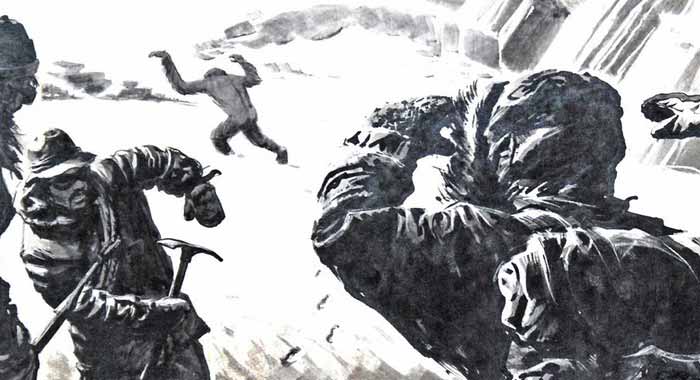
What is the Yeti?
The Yeti, or Yet-heh (a Sherpa phrase simply meaning “That Thing”), is a globally recognized cryptid, perhaps the first true celebrity of cryptozoology. The Yeti resides in the Himalayan Mountain range and inspired high-profile expeditions from the Western world to prove its existence in the mid 20th century. The creature was always a facet in Nepalese spiritual culture, but it did not gain worldwide intrigue until 1951 when a set of giant footprints were photographed at the base of Mount Everest.
What is the Abominable Snowman?
The term Abominable Snowman comes from a convoluted series of mistranslations between the Nepalese and Westerners in the early 20th century. The Abominable Snowman and the Yeti are one in the same.
What does a Yeti look like?
Unlike the North American cousin Sasquatch, the Yeti stands on average five and a half feet tall. It is not as physically imposing as Sasquatch, but still features a hulky build, exceptionally long arms, massive shoulders, and a distinct cone-shaped head. Eyewitness reports and Sherpa stories describe the creature as dark in color, usually with short, coarse, reddish hair. The rare creatures have been seen in pairs, wandering casually over snow banks and across mountain passes.
Yeti Sightings and Evidence
The first western reference to the Yeti came in the Journal of the Asiastic Society of Bengal in 1832. The text describes stories from native Nepalese hunters who witnessed tall, hairy, ape-like creatures in the mountains, originally thought to be orangutans.
Yeti sightings are rare. Evidence is just as sparse. But the one piece of ‘proof’ that truly started the Yeti craze was a photo snapped in 1951. Experienced Himalayan mountaineer Eric Shipton took a crew of English climbers to Tibet. Their goal was to discover a more manageable route to Mt. Everest. Among the crew was a young Edmund Hilary, who would become the first man to ever reach the peak. One afternoon while mulling around the 18,000 foot base camp, the team came across unique footprints in the snow that led down a glacier. The barefoot prints were deep, 5” wide, 12” long. Shipton placed a pick axe next to the prints for scale, snapped a photo and the rest was history. The perplexed crew had no explanation for the animal that made the print, since they were so far above the tree-line. But Sherpa guides along for the expedition immediately knew what made them: a Yeti.
Expeditions in the 70s and 80s to prove the existence of the cryptid turned up little more than what was already known. Many footprints were observed, but ultimately linked to bear prints most likely accentuated by snow melt. A compelling account comes from British mountaineer Don Whillans in 1970. After hearing strange cries around the base of Annapurna, he claims to have observed an ape-like creature foraging in the bush for over twenty minutes.
The Yeti and Tibetan Culture
The concept of a Yeti is deeply ingrained in Himalayan culture. Across the mountain range, each region knows it by different names: Yeti, Chemo, Tenmo, Dzu-the, and more. The creature, whatever you may call it, usually represents a negative spiritual force in the mountain. Drawn and painted as dark and monstrous, the Yeti is feared as something of a watcher in the mountains, looking out for people who commit bad deeds. Festivals and ceremonies often include Sherpas dressed as the creature. The embodiment of anger, bad luck, and misfortune, the characters antagonize the village people. Ultimately the monster is driven back to the mountains at the conclusion of the performance.
The Yeti in Media
The Yeti enjoyed a massive blast of popularity in the 50s and 60s after the Shipton print and before Jerry Crew’s California Bigfoot casts. For some middle to upper class Americans, the Yeti became the exotic focal point of a series of strange, fantastical expeditions to the Himalayas in the 1950s. Billionaire playboy Tom Slick and friend Jimmy Stewart headlined this eccentric group. Paralleling western intrigue in mountain climbing, Indiana Jones-type adventures to find the Yeti became popular.
There are many films, books, and television shows about the Abominable Snowman. In fact, when it comes to bipedal relic hominids in entertainment, the Yeti probably falls just short of Bigfoot/Sasquatch in popularity. Two of the most admired incarnations of the Yeti are the Snowman from Rudolf the Red-Nosed Reindeer and the Wampa creature from The Empire Strikes Back.

Sources:
Coleman, Loren, and Jerome Clark. Cryptozoology A to Z: The Encyclopedia of Loch Monsters, Sasquatch, Chupacabras, and Other Authentic Mysteries of Nature. New York, NY: Simon & Schuster, 1999. Print.
“Yeti.” UnknownExplorers.com.


